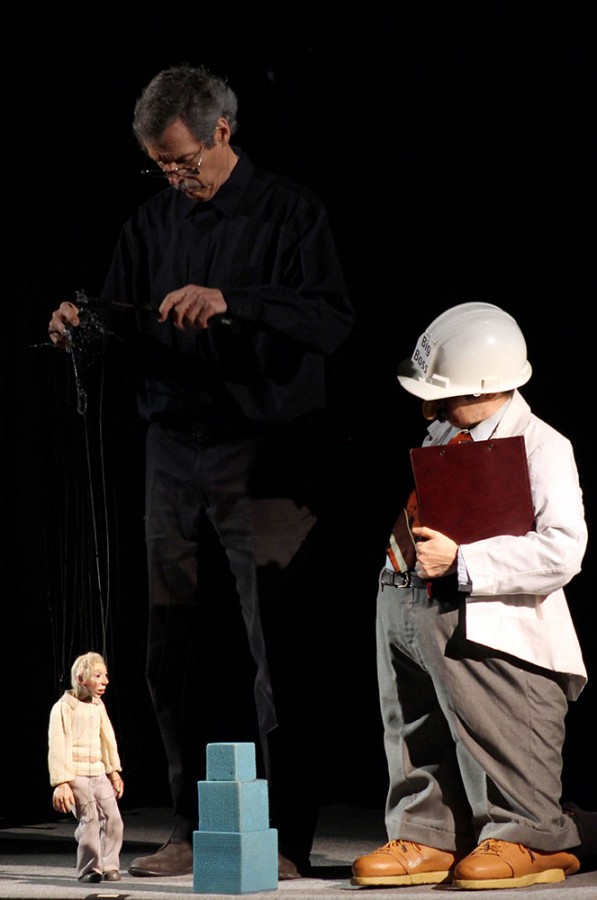Puppeteer tugs on heartstrings
March 4, 2015
A petite head bent intently around the neck of violin as marionette hands interpreted the hasty tugs of their puppeteer, Joe Cashore.
In a hushed auditorium as a tiny body suspended from string took its final bow, what began as a marionette show more closely resembled a live classical performance.
Cashore, who has been in the business of marionette making and puppeteering for 30 years, performed “Life in Motion,” a 12-act series Monday in the Recital Hall of the Doudna Fine Arts Center.
The first time Cashore’s eyes met the dangling and purposeful joints of a marionette, he knew moving them, even just a little, would give him satisfaction.
Unfortunately, Cashore came to this understanding as a 10-year-old boy, and his request to play with the puppet on display at a local store was denied.
Just one year later Cashore would compose his own marionette of clothespins, wood, string and a tin can.
“It really wasn’t a very good marionette,” he said. “But every once in a while it would move really well and look like it was alive.”
Mike Finney, a Charleston resident, said the performance exceeded any expectations he had, in part because of Cashore’s commitment to the quality of his marionettes.
“He has a very personal relationship with them,” he said. “I think you’d have to, to make the story seem real to the audience.”
A sense of realism is precisely what Cashore said attracts him to marionettes. This is why he spends as many as 42 strings and at least six months of crafting, wiring and testing each of his marionettes. Although today he could have studied puppeteering at a public university, Cashore said the quality of a performance relies mainly on creativity.
“All the ones I know who are doing really intricate work seem to be doing their own thing,” he said.
The puppeteer has hand-made 150 marionettes and an outfit for each. A painter, Cashore said the developing process is an important and intimate experience.
“I always try to feel with the character and it’s a big part – the longer you use marionettes the more the character reveals itself to you,” he said.
Cashore said some of the marionettes create themselves along the way, and between their characters and Cashore’s imaginiation, he has composed a show he hopes speaks about the human condition to some extent.
“It’s a metaphor for living,” he said. “There’s an inherent poetic quality to these marionettes – there’s a very strong illusion.”
Bart Rettberg, the assistant sports information director at Eastern, said the show’s music took Cashore’s performance to a meaningful place.
“It almost brought tears to my eyes because I like hearing Copland and he used a lot of Aaron Copland music, which is great,” he said.
Although he may have seemed invisible, the climate of an audience is a factor Cashore is ever-conscience of.
“I like feeling that connection with the audience when everyone is feeling the same thing at the same time in the same place,” he said. “There’s a sensation there.”
Although children were present, Cashore does not write his shows to be viewed by a young audience. Topics like homelessness, death and elephant poaching are intended for a more mature audience, he said.
“It’s not for toddlers. It’s not the appropriate audience,” he said. “I like to look out there and see mostly mature people.”
If you tell Cashore he is an artist he will tell you he only tries to perform his best on a level of marionette performance most have never known – one he discovered at a young age.
“I was just a kid and I was in a store,” he said. “It just seemed like it had a lot of possibilities.”
Katie Smith can be reached at 581-2812 or kesmith2@eiu.edu.














![[Thumbnail Edition] Charleston High School sophomore Railyn Cox pitches the ball during Charleston's 8-7 win over Flora High School on Monday, March 31.](https://www.dailyeasternnews.com/wp-content/uploads/2025/04/SBHS_01_O-1-e1743982413843-1200x1023.jpg)

![[Thumbnail Edition] Senior Foward Macy McGlone, getsw the ball and gets the point during the first half of the game aginst Western Illinois University,, Eastern Illinois University Lost to Western Illinois University Thursday March 6 20205, 78-75 EIU lost making it the end of their season](https://www.dailyeasternnews.com/wp-content/uploads/2025/03/WBB_OVC_03_O-1-e1743361637111-1200x614.jpg)













![[thumbnail edition] Assistant Coach of the Linebackers, Rodman Noel talking to the linebackers about their positions at O'Brien Field on the Eastern Illinois University campus, Charleston Ill.](https://www.dailyeasternnews.com/wp-content/uploads/2025/04/FB_24_O-1-e1744671213207-1200x609.jpg)
![[THUMBNAIL EDITION] (From left to right) Head football coach Chris Wilkerson works with his son student assistant coach Peyton Wilkerson at football practice at O'Brien Field on the Eastern Illinois University campus on Thursday.](https://www.dailyeasternnews.com/wp-content/uploads/2025/04/FB_25_O-1-e1744234837107-1200x596.jpg)











































